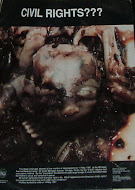 As a young lad I traveled to a small housing estate (of the kind labeled "sink estates") in the Rhondda Valley in a town called Ferndale. The estate was called Penrhys.
As a young lad I traveled to a small housing estate (of the kind labeled "sink estates") in the Rhondda Valley in a town called Ferndale. The estate was called Penrhys.
Right: Penrhys, just another 1960s sink estate in the Rhondda Valley.
I was with a friend and we were visiting a Welsh-speaking NF comrade who had moved up the valleys to see him and his young family.
In the middle of this really quite grim 1960s housing estate with all the 'flotsam and jetsam' of wrecked cars and swirling rubbish, was a strange statue on a large pillar. It was of the Virgin Mary and the Infant Christ.
It seemed strangely out of place, to the extent of almost appearing as a strange discovery, by myself, of an unknown artifact.
Having a love of all things historic, loving travel and being quite the amateur photographer in those days of 35mm and sending your film off to Truprint (you got a free one back y'know!), I got my friend to take a photo of me (budding Indiana Jones that I was) by the statue.
I thought nothing more of it. I still have the photo somewhere, in a box amongst the keepsakes and bric a brac of a dozen or so house moves.
Well just the other day I was speaking to someone originally from the valleys and the name Penrhys popped up.
I was intrigued. It rang a faint little bell at the back of my mind.
He told me that the community there was trying to reinvigorate itself and bring a bit of pride and a sense of belonging to an area long ago written off by many.
A part of this has been the study of the pre-Reformation pilgrimage to the statue which had a particularly special place in the hearts of the Welsh people, but was in fact second only in popularity in the whole of the Britain to the famous Walsingham Marian pilgrimage, which was supported by Royalty and the powerful.
If you read the pdf document which details the history of Penrhys, you'll even see that Owain Glyndwr may well have attended an Eisteddfod at the Monastic grange established there by the Cistercians.
What I think is particularly good about this project is that it is helping one of the poorest areas (hitherto ignored as the "inner cities" and multi-culti deprivation soaked up money to no avail) which is almost wholly indigenous.
As part of the renovation of a real community, the history and heritage of the local land is playing a central part and so what was a grimy, underprivileged housing estate is learning of its past as a part of Welsh history, and a place that was regarded by people thoughout Europe as a great place of pilgrimage, with a special loyalty of the poor.

Left: The current reconstruction of the original Penrhys statue.
What Henry VIII and Thomas Cromwell tried to wipe out like thieves in the night for fear of a "local uprising" and what the bards of old had written and sung about as a wonderful place could well be reborn... and short of some shipped in corner shop Hindus to appear all "inclusive" this will see a small corner of Wales retain what was once its position as a beacon for our people, in showing what a local community - when it still has a sense of community - can achieve.
Link:
Penrhys.com click on Pennrhys Pilgrims (pdf download file)
The Cistercian Way to Penrhys



































0 comments:
Post a Comment